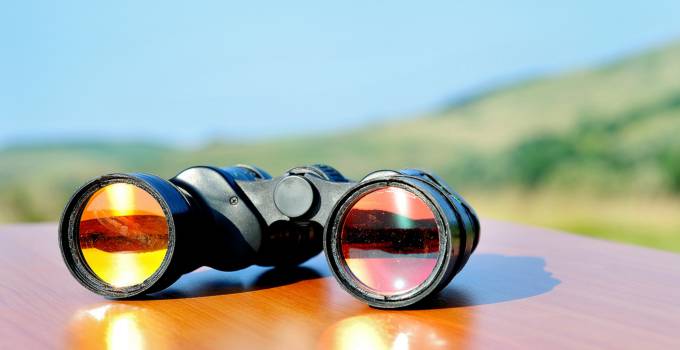Ever had your binoculars suddenly go all foggy, making it nearly impossible to see clearly? Well, there is a simple explanation for this phenomenon.
Changes in temperature and humidity can cause moisture to enter your binoculars, resulting in the fogging up of inner optical surfaces. This moisture not only disturbs visibility but can also cause damage to sensitive parts of your binoculars.
Fixing the fog is not easy. It can also lead to long term issues because damp places are perfect for mold to grow. Mold can damage your binoculars and make them stop working. Your binoculars will be permanently damaged if you do not remove moisture from inside.
In this article, we will discuss what you can do to keep your binoculars fog and moisture free for your next adventure.
Tips to Prevent Water Entry into Binoculars
The most important thing you should consider is how to prevent water or moisture entering your binoculars, in the first place. Go through the following tips to know how you can prevent water from entering your binoculars.
Buy water resistant binoculars
The smartest way to deal with water in binoculars is to stop it from getting in there. Some binoculars are called ‘fogproof’ which means they are also waterproof. They have a sealed chamber filled with special dry gas like argon or nitrogen that stops moisture from forming inside.
This gas also kicks out the regular air. You can find out which gas they use by checking the binoculars description or specs. Using this gas keeps the inside clear of moisture and prevents molds from growing in there.
Use protective accessories
If you own a pair of binoculars that are not water proof and fog proof then you should buy protective casing for your binoculars to keep them safe from wet weather conditions like rain.
Protective cases prevent the binoculars from many different types of harms apart from protecting them from moisture and water. These include protection from scratches, dust and debris, damage and breakage due to rough handling. You should also have lens caps for protection of your lenses so that water and dust can not enter.
Keep Binoculars Dry in Wet Conditions
If you are out for an adventure and it starts raining then a moisture absorbing bag of rain cover will really help you keep your binoculars from getting wet and fogging up inside. You should have a waterproof bag in which you can store your binoculars when it starts raining or when you are going for a sightseeing adventure in wet weather conditions.
Best Tips for Removing Moisture from Your Binoculars
Worried about moisture trapped inside your binoculars? Here are a few easy tips you can carry out at your home to defog your binoculars.
Using desiccants
You can use drying agents like uncooked rice and silica gels to absorb moisture from the binoculars. These are easily available and you can do this process at your home. Simply put your binoculars in an airtight bag along with some rice and silica gels. It will help remove the moisture from binoculars within 24 hours. In severe cases, it may take longer than a day to dry.
Blowing cold air gently
Blowing unheated air to dry the binoculars also helps in removing the moisture trapped inside them. Make sure to blow dry the outside of the binoculars first so that no further water can enter them. Remember not to dry your binoculars with hot air as it can cause further damage to the lenses or other parts of binoculars.
Keeping Binoculars in a Dry Place For Natural Air Drying
Place your binoculars in a spot where the air can move around them and the room is not too hot or too cold. This helps the inside moisture dry up on its own. Make sure they are not in the hot sun or near things that give off heat, as this can damage sensitive parts. This might take a while so be patient while waiting for them to get better.
Store in a dry place
After every use, store the binoculars in a dry place so that there is no chance of moisture entering the binoculars. This is especially useful in humid areas and weather conditions. Storing in a dry place may prevent moisture from fogging up the binoculars.
Taking expert advice
Binoculars are sensitive tools with delicate parts. If you do not know how to keep your binoculars fog-free, then you should always get expert help. You can read binocular manufacturers manual or call helpline for further guidance. You can also visit your nearest store for help.
How Can You Clean The Inside of Binoculars?
If you are thinking about cleaning the inside of your binoculars then it is best not to do it yourself. Taking them apart can disturb the alignment of lenses. It should really be done by an expert. Doing it on your own can cancel the warranty and make the binoculars open to scratches, moisture and dirt.
If you absolutely need to clean the inside, use a special cleaning solution and cloth made for lenses to make sure you do not damage anything. If you decide to take the binoculars apart then you should start by unscrewing the cap, then take off the eyepieces and remove cover to get to the prisms. Then take off the bottom part to clean the inside of objective lens at the front.
Prevention Is Better Than Cure
It is always better to prevent your binoculars from harsh conditions and rough handling than trying to fix the damage done. To make sure your binoculars do not get messed up by moisture you should take steps to prevent it. When you are not using your binoculars, keep your binoculars in a cool and dry spot. If you are taking them in different temperatures then use a sealed container or a bag that closes tightly to protect them. Also putting little packets of silica gel in your binocular case can help soak up extra moisture.













